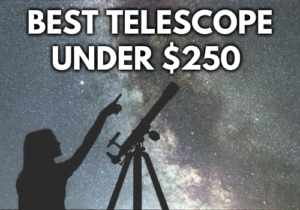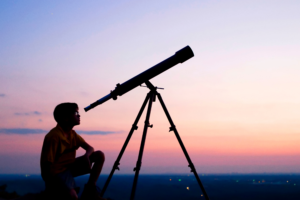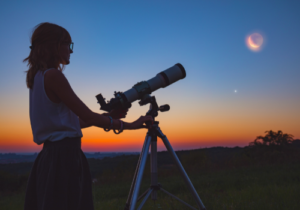
7 Best Telescope For Amateurs 2026; Reviews
Disclosure: This post contains affiliate links and I may earn a small commission (at no extra cost to you) if you click through and make a purchase. Thanks in advance – I really appreciate it!
Our comprehensive review of the best telescope for amateurs will introduce you to some amazing telescopes that will enable you to scope out this stellar scenery and satisfy your cosmos curiosity.
Top 3 Picks
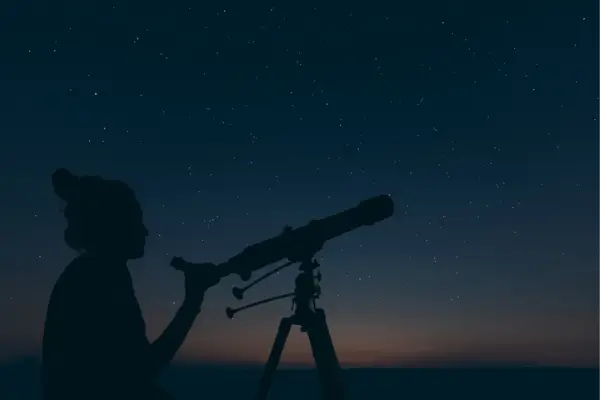
Who is this article for?
The information provided in this article is mainly for amateur astronomers, beginners, kids, or if you are someone looking for a telescope that can be used by your entire family with minimum supervision and the least amount of set-up time.
We have carefully chosen the telescopes that are designed to help you become familiar with the night sky.
Using one of these scopes, you can start with a look at the moon, move on to the planets of our solar system, and then venture on to the “deep sky” to examine star clusters, nebulae, and galaxies.
During our research we found telescopes that had the appropriate range to start a new astronomer out and then keep them involved.
Since we were majorly focussing on the needs of an amateur during our research, we have limited our testing pool to telescopes that were about $600 or less.
Once you extend your budget, telescopes become more specialized, and when you reach that stage you likely already know what specific features you’d like to spend more on.
Best Telescope For Amateurs
Fortunately, there is no lack of options when it comes to finding the best telescope for amateurs or for the entire family to enjoy home astronomy.
As a beginner, the key questions you need to ask yourself are: what do you want to be able to see? How much room do you have to keep the telescope when you’re not using it? How much do you want to spend?
1. Celestron – PowerSeeker 127EQ
- PERFECT ENTRY-LEVEL TELESCOPE: The Celestron PowerSeeker 127EQ is an easy-to-use and powerful telescope. This 127mm Newtonian Reflector offers enough light gathering ability to see planets, the Moon's craters, distant stars, the Orion Nebula, and more.
- MANUAL GERMAN EQUATORIAL MOUNT: With its slow-motion altitude rod, the German Equatorial mount allows you to navigate the sky with ease. Find celestial objects quickly and follow them smoothly & accurately as they appear to drift across the night sky.
- COMPACT AND PORTABLE: The ideal telescope for adults and kids to use together, the PowerSeeker is compact, lightweight, and portable. Take it to your favorite campsite, a dark sky observing site, or simply the backyard.
- MULTIPLE ACCESSORIES: The Celestron PowerSeeker 127EQ Telescope comes with 2 quality eyepieces (20mm and 4mm) plus a 3x Barlow lens to triple the power of each. You'll also receive a FREE download of one of the top-rated astronomy software programs.
- UNBEATABLE WARRANTY & SUPPORT: Buy with confidence from Celestron, a leading telescope brand in California since 1960. Your purchase includes a 2-Year US Warranty and unlimited support from our team of US-based experts.
The Celestron PowerSeeker 127EQ telescope is a Newtonian reflector, which means it uses mirrors to gather the light of the skies, and reflects it for viewing. With mirrors being much less expensive to produce than glass lenses, reflector telescopes offer more value in terms of inches of aperture.
The PowerSeeker 127EQ comes with two eyepieces (4mm and 20mm) and a 3x Barlow lens.
The 5-inch mirror on the 127mm PowerSeeker model limits useful magnification to about 250x, which is achieved using the 4mm eyepiece.
The larger 20mm eyepiece provides a more useful 50x magnification. This grows to 150x when coupled with the 3x Barlow.
If you’re considering an additional eyepiece, something like a 15mm Plossi would be a good option. This provides you with 66x magnification, or 198 when coupled with the Barlow.
The telescope is ideal for near and deep-sky observation, Celestron’s PowerSeeker 127EQ 127mm f/8 Reflector Telescope features a respectable focal length and a large, parabolic mirror that produce detailed images of the Moon, clear views of the planets, and the ability to resolve bright distant objects such as nebulae and galaxies.
This telescope comes with an Equatorial mount, designed for astronomy telescopes. Included are two manual slow-motion controls, these allow for smoother tracking of objects as they pass across the night sky.
The tripod is made of aluminum, although lightweight, it is robust, solid and also comes with a very handy accessory tray which lets you keep extra eyepieces and T-rings for a camera, close to hand.
Pros:
- Solid build quality
- Stable mount
- Comes with a 3x Barlow lens
Cons:
- Spherical mirror leads to some amount of aberrations
- Occasional collimation of the mirrors required
2. Gskyer Telescope
- 【High Quality Optics】600mm(f/6.7) focal length and 90mm aperture, fully coated optics glass lens with high transmission coatings creates stunning images and protect your eyes.
- 【High Magnification】Come with three replaceable eyepieces(24X, 60X,120X) and one 3x Barlow lens. 3x Barlow lens trebles the magnifying power of each eyepiece
- 【Adjustable Tripod】This telescope allows for many different viewing positions with a adjustable aluminum tripod. The height of aluminum tripod can be adjusted from about 31.5-inch to 49-inch
- 【Easy to Operate】No tools are required for reflecting telescope even for the novice, quick and easy to focus
- 【What You Get】AZ90600 telescope with 3 eyepieces, our 12-month worry-free support and friendly customer service.
This is a great starter telescope for the explorer who intends to take their telescope with them on their journeys. Hiking, camping, and even moonlit fishing trips will be more fun when you have this telescope along with you.
The Gskyer AZ90600 is one of the best refractor telescopes for amateur astronomers. If you live in the city and you aren’t able to see much of the sky due to light pollution, you’ll want a telescope like this that’s easy to carry with you.
The 90 millimeter aperture is perfect for viewing most of the things you’d want to view, and all of the glass optics are coated to automatically adjust the brightness of the stars to a level safe and comfortable for observation.
Though this is a beginner telescope, you can use it to observe the moon, stars, meteors, and planets. The telescope offers great clarity, allowing you to see the surface of the moon, the rings of Saturn and the moons of Jupiter.
It also comes with a smartphone adapter, which allows you to use the phone as a screen, or as a camera to take great pictures.
Plus, this model is extremely easy to assemble and doesn’t require any calibration. If you’re a telescope beginner, you won’t have to worry about any tricky steps or complicated tests.
The Gskyer AZ90600 comes with an adjustable tripod. This adjustable aluminium tripod offers the viewer many different viewing positions. The height of the aluminum tripod can be adjusted from about 31.5-inch to 49-inch.
It’s 90mm (3.5″) aperture gives bright, sharp images for both land and celestial objects.
Pros:
- Large aperture
- 3 eyepieces
- Smartphone adapter
- Easy to assemble and use
- Adjustable tripod
- Perfect travel telescope
Cons:
- Good for viewing planets, stars not so much
3. Celestron – PowerSeeker 70EQ
- PERFECT ENTRY-LEVEL TELESCOPE: The Celestron PowerSeeker 70EQ is an easy-to-use and powerful telescope. This 70mm refractor telescope offers enough light gathering ability to see planets, the Moon's craters, distant stars, the Orion Nebula, and more.
- MANUAL GERMAN EQUATORIAL MOUNT: With its slow-motion altitude rod, the German Equatorial mount allows you to navigate the sky with ease. Find celestial objects quickly and follow them smoothly & accurately as they appear to drift across the night sky.
- COMPACT AND PORTABLE: The ideal telescope for adults and kids to use together, the PowerSeeker is compact, lightweight, and portable. Take it to your favorite campsite, a dark sky observing site, or simply the backyard.
- MULTIPLE ACCESSORIES: The Celestron PowerSeeker 70EQ Telescope comes with 2 quality eyepieces (20mm and 4mm) plus a 3x Barlow lens to triple the power of each. You'll also receive a FREE download of one of the top-rated astronomy software programs.
- UNBEATABLE WARRANTY & SUPPORT: Buy with confidence from Celestron, a leading telescope brand in California since 1960. Your purchase includes a 2-Year US Warranty and unlimited support from our team of US-based experts.
The 70EQ Power Seeker is a refractor telescope with a 70mm aperture and a focal length of 700mm. Its low price combined with excellent optics, easy assembly, clear instructions, included eyepieces and other features that make it easy to use even for beginners, make it an excellent choice for anyone wanting to learn more about the nighttime sky.
At f/10, there is some chromatic aberration but nothing significant enough to ruin high-power views with this telescope. The optical quality of the Powerseeker 70 is quite good.
The scope’s focuser is a 1.25” rack-and-pinion made mostly of plastic. The focuser even includes a tension adjustment knob, should you find the focuser to be too loose or too tight.
Since Celestron 21037 PowerSeeker 70EQ telescope is a family-friendly scope, it is very easy to set up and use as it needs no extra tools. The instructions manual clearly describes every setup step, giving clear information on each of the telescope’s parts and uses.
With an aperture of 70 mm (2.76“) and a focal length of 700 mm (28”), the Celestron Power Seeker telescope allows stargazers to see the Moon, Jupiter, Saturn and other celestial wonders with ease.
The 3x Barlow lens manages to triple the magnifying power of all eyepieces, while the 1.25″ Erect Image Diagonal makes the telescope ideal for both astronomical and terrestrial use.
The equatorial mount supplied with the 70EQ is actually a good match for it. The motions are reasonably smooth, the mount’s extruded aluminum legs are quite steady with such a lightweight tube. Furthermore, the whole setup is pretty light at about 14 pounds.
Pros:
- Family-friendly, easy to setup and use
- Coated glass, decent optical components
- EQ mount with slow motion controls
- Budget option refractor telescope for astrophotography
- High and low power eyepieces
- Ideal for both terrestrial and celestial viewing
Cons:
- Not suitable for professional use
- Most components are built with plastic
4. Sky-Watcher Flextube
- LARGE APERTURE: Get a bright, bold viewing experience at a fraction of the cost of other optical designs.
- INNOVATIVE COLLAPSIBLE DESIGN: Unique strut design allows for optical tube to collapse for ease of portability while keeping collimation.
- PROPRIETARY TENSION CONTROL HANDLES: These patented handles allow for accurate movement without the need for perfect balance.
- 94% REFLECTIVE MIRRORS: Fully multi-coated borosilicate primary and secondary mirrors deliver exceptional views.
- TEFLON BEARINGS: Proprietary Teflon bearings ensure smooth azimuth movement.
Sky-Watcher 8″ Collapsible Dobsonian Telescope features an elegant truss tube design that was carefully engineered to combine ease of use, extreme portability and consistent performance in an affordable package.
Unlike other truss tube designs, the Sky-Watcher Collapsible Dobsonian does not need to be disassembled between uses.
It transports as two compact pieces that can be assembled and ready to use in minutes. It is easy to collimate once set up, and it holds its collimation throughout the viewing sessions.
It is essentially a Dobsonian style Newtonian with a large 8″ aperture which is ideal for beginners who can invest a fair amount as well as professionals.
The telescope comes with a great focal length of 1200mm and with a focal ratio of f/6.
The Sky-Watcher 8″ Collapsible Dobsonian features a 2″ single speed Crayford style focuser and comes with a 1.25″ adaptor.
25mm and 10mm 1.25” super Plossl eyepieces are included. Metal construction, captive recesses on the barrels and rubber fold-down eye-cups make these good quality eyepieces that are certainly adequate to get you started.
This is one of the best telescope for amateurs for DSOs as it has a low-hassle OTA design which is not only simple in construction and use but it also provides the viewer with maximum light for viewing deep space objects without any aberrations or blurriness.
The mount construction is sturdy and rigid. Mount design, while simple, facilitates smooth motions about both axes.
The Sky-Watcher 8” comes with quality accessories that enhance the observer’s viewing experience.
Pros:
- Easy to transport due to collapsible tube design
- Focuses very accurately
- Easy to use
- Can be used by beginners & professionals
- Viewfinder helps in easy spotting of objects
- Built with high quality materials
Cons:
- Doesn’t come with a Barlow lens
- Needs a light shroud
5. Celestron – NexStar 6SE
- ADVANCED TECH MEETS ICONIC DESIGN: The NexStar 6SE pairs Celestron’s legendary orange tube with a fully computerized GoTo system—ideal for those ready to step up from manual scopes and explore more of the night sky with precision and ease.
- 6-INCH SCHMIDT-CASSEGRAIN OPTICS: The large 6" aperture gathers enough light to reveal fine lunar details, cloud bands on Jupiter, and deep-sky objects like galaxies and globular clusters—all in a compact, portable form factor.
- FULLY AUTOMATED GoTo MOUNT WITH NEXSTAR+ HAND CONTROL: Use the NexStar+ hand control to select from a 40,000+ object database. The computerized mount then automatically slews to your target and tracks it—no star charts or manual alignment needed.
- FAST & EASY ALIGNMENT WITH SKYALIGN TECHNOLOGY: SkyAlign gets you observing fast—just center any three bright stars or planets, even if you don’t know their names. The system then calculates your position and aligns the mount in minutes.
- COMPATIBLE WITH CELESTRON ACCESSORIES: Easily upgrade your setup with all our latest accessories to enhance automation, wireless control, or location accuracy as your skills grow.
The NexStar 6SE offers consumers the proven quality of the Celestron brand in a compact, portable, and technologically advanced telescope.
The scope’s 6-inch aperture, portable design, fully functional computer, and extensive database, among other features, make it easy to use, easy to transport, and easy to enjoy regardless of experience level. The NexStar 6SE is quite evidently the best computerized telescope for amateur astronomers.
The NexStar 6SE is a 6-inch Schmidt Cassegrain Telescope, which has an actual aperture of 150 mm and focal length of 1,500 mm, giving it a focal ratio of f/10. The OTA comes on a Vixen-style dovetail bar, which fits into the dovetail saddle on the mount.
The telescope also comes with a 1.25” prism diagonal, 25 mm Plossl eyepiece (providing 60x when used with the 6SE) and Celestron’s StarPointer, which is a zero-power red-dot-style finder.
The Celestron NexStar 6 SE is a solid and sturdy telescope, perfect for home use and astrophotogaphy.
The Celestron NexStar 6 SE is easy to align with Celestron’s SkyAlign Go-To Alignment system.
The 6SE makes a good choice for consumers living in areas with light-pollution who are looking for clarity and accuracy in their viewing experience.
Pros:
- Easy to mount and to use
- Good optics
- It’s very sturdy and low maintenance
- Motorised and automated GoTo mount
- Portable, fits perfectly in the back of any normal car
Cons:
- 8 AA batteries tend to drain out fairly quickly
- User manual and instructions are not very clear
6. Celestron – NexStar 127SLT
- COMPUTERIZED STAR LOCATING TELESCOPE: The Celestron NexStar 127SLT offers a database of more than 40,000 stars, galaxies, nebulae, and more. Simply choose an object and the telescope finds it for you in the night sky and tracks it as it moves.
- MAKSUTOV-CASSEGRAIN OPTICAL DESIGN: With a large, 127mm aperture, the NexStar 127SLT can gather enough light to see our Solar System and beyond. View Saturn’s rings, Jupiter’s cloud bands, the Moon's craters, and the Orion Nebula in brilliant detail.
- COMPACT AND PORTABLE: The ideal telescope for adults and kids to use together, the NexStar 127SLT is compact, lightweight, and portable. It's easy to transport just about anywhere—your favorite campsite, a dark sky observing site, or simply the backyard.
- FAST SETUP WITH SKYALIGN: Celestron’s proprietary SkyAlign procedure has you ready to observe in minutes. Center any 3 bright objects in the eyepiece and the NexStar SLT aligns to the night sky, ready to locate thousands of objects.
- BONUS FREE STARRY NIGHT SOFTWARE: Your Celestron NexStar 130SLT includes a free download of Starry Night Special Edition, one of the top-rated astronomy software programs. Simulate the sky, learn about celestial objects, & plan your observing session.
The Celestron NexStar 127SLT is an entry-level GoTo telescope designed for anyone looking for a reliable telescope with which to enjoy the nighttime sky.
The telescope features a 127mm aperture and Celestron’s SkyAlign technology, this telescope offers consumers good views. In addition, the telescope’s single fork arm and simple design make it easy to set up and use.
The scope’s focal length is 1500mm, and it has a focal ratio of f/12. As far as eyepieces are concerned, each Celestron NexStar 127 SLT telescope comes with a 25mm eyepiece and a 9mm eyepiece, having a maximum magnification of 167x with the default 9 mm eyepiece.
The Celestron NexStar 127 SLT telescope stands on top of a motorized Altazimuth mount, which can be controlled via the provided digital hand controller.
Alternatively, the mount can be hooked to a computer for increased precision.
With preassembled, adjustable stainless steel tripods, and quick release fork arms and tubes, the NexStar 127 SLT telescope can be set up in a matter of minutes with no tools required.
The 127 SLT with its large aperture is great for viewing the surface of the moon, phases of Venus, rings of Saturn or Jupiter and its four largest moons, and other deep-space objects.
Pros:
- Super optical construction
- Very easy to operate with
- Compact and portable design
- Included needed additional accessories
- Suitable for lunar/planetary astrophotography
Cons:
- 8 AA batteries required but not included
- Tripod can be more stable
7. Gskyer Telescope 70mm
- Superior Optics: 400mm(f/5.7) focal length and 70mm aperture, fully coated optics glass lens with high transmission coatings creates stunning images and protect your eyes. Perfect full positive telescope for astronomers to explore stars and moon.
- Magnification: Come with two replaceable eyepieces and one 3x Barlow lens.3x Barlow lens trebles the magnifying power of each eyepiece. 5x24 finder scope with mounting bracket and cross-hair lines inside make locating objects easily.
- Wireless Remote: This refractor telescope includes one smart phone adapter and one Wireless camera remote to explore the nature of the world easily through the screen and take amazing celestial images.
- Adjustable Tripod: This telescope allows for many different viewing positions with a adjustable aluminum alloy tripod and a carry bag, the telescope and tripod can fit inside the bag for easy traveling and storage.
- Satisfaction: Buy with confidence from a leading manufacturer.
The Gskyer’s AZ70400 Telescope is a 70mm aperture and 400mm short focal length refractor telescope mounted on a camera type tripod. It includes a 45 degree diagonal, a carry case, finder scope, two eyepieces, and a 3x Barlow lens.
The overall assembly of the telescope is straightforward and perfect for anyone with little to no prior knowledge.
The included 3x Barlow lens, 25mm, and 10mm eyepiece all offer varying levels of magnification. The maximum magnification is x120 and provides clear images of the moon, planets, and some star arrangements.
The telescope comes with an altazimuth mount screw tripod made of aluminum alloy for support and stability while viewing distant objects.
It also comes with a smartphone adapter which can be used to fix your iPhone/Android to the telescope for astroimaging of the night sky.
In addition, the telescope comes with a rack and pinion mechanism to assist the focuser in bringing distant objects closer for easy and detailed viewing. The slow motion lever enables you to track celestial objects in motion quite easily.
Because of its rugged design, this type of telescope provides reliable performance in the most demanding conditions so images are kept steady, with no interferences or reflections on the path of light.
Pros:
- Easy to setup and use
- Very portable
- Perfect for beginners and family
- Decent optics
- Comes with its own backpack
- Robust design
Cons:
- Instruction manual is a bit vague
- Difficult to collimate
Amateur Telescope Buying Guide
Buying a telescope is an important first step towards a new level of appreciation for the night sky, and the wonders found within it.
The best telescope for amateurs is one that guides you through the process of learning the night sky in a straightforward and gratifying way. It’s easy to get swept away with an optical instrument that is likely too complex for a beginner to learn early on.
Here is a comprehensive telescope buying guide which will explain the importance of all the parts of a telescope and the important features that you should look for when purchasing your first telescope.
Features To Consider When Choosing A Good Telescope For Amateurs
A telescope is an amazing device that has the ability to make faraway objects appear much closer. Telescopes come in all shapes and sizes, from a little plastic tube you buy at a toy store for $2, to the Hubble Space Telescope, which weighs several tons.
Amateur telescopes fit somewhere in between, and even though they are not nearly as powerful as the Hubble, they can do some incredible things.
As an amateur astronomer- Here are the different features of a telescope that you need to know about before making a final purchasing decision.
Lenses & Mirrors
Depending on whether it is a refracting or reflecting telescope, the primary light-gathering part of a telescope is its primary mirror or lens — the bigger the lens or mirror of the telescope. Therefore, bigger is better when it comes to the lens or mirror size of a telescope.
While consumer telescopes can be either reflecting or refracting, the true scientific or astronomical telescopes used by scientists are always reflecting telescopes, like the above mentioned The Hubble Space Telescope.
Mirrors are amenable to precision manufacturing and can have smoother surfaces than lenses. Lenses also bend the light of different wavelengths differently, introducing complications in focusing the final image.
Eyepiece Holder & Focuser
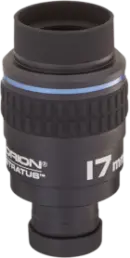
The eyepiece holder holds the eyepiece and they are available in three sizes — 0.965 inches (2.45 cm), 1.25 inches (3.18 cm), and 2 inches (5.08 cm) in diameter. The focuser moves the eyepiece holder and adjusts the focus of the eyepiece.
Aperture
Aperture might be the most discussed component of a telescope. The aperture is the diameter of the telescope’s mirror or lens, and it determines how much light the telescope lets in and, in turn, how sharp the image appears.
One mistake that beginners make when choosing their first telescope is thinking that bigger aperture is always better when it comes to aperture. Bigger aperture generally means a higher price and a bulkier telescope.
As a thumb rule – a refractor telescope should have a 6-inch (150 mm) mirror at least while a reflector telescope requires a 4-inch lens.
Focal length
It is the distance between a telescope’s primary optics and its focal point. It works with the focal length of your eyepiece to produce your desired magnification. In many cases you will get the telescope’s focal ratio instead. This is just the ratio between the focal length of the telescope and its aperture.
Magnification
The focal length is important, because it’s a factor in how well a telescope magnifies objects.
To figure out the magnification, divide the focal length of the telescope by the focal length of the eyepiece:
If you have a 25-millimeter eyepiece and a refractor of 900 mm, the magnification is 36 power, written as 36x (or, 900 / 25 = 36).
To avoid fuzziness, make sure to magnify a telescope to no more than twice the aperture of your telescope in millimeters.
Finderscope
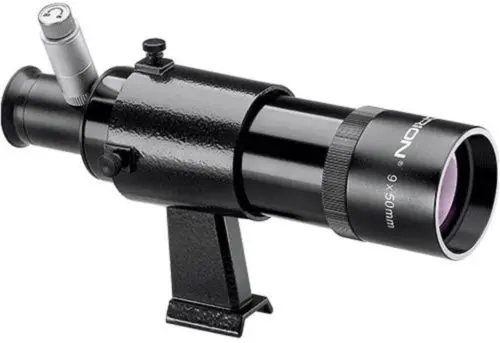
A finder scope comes included with a telescope and is normally mounted on the telescope itself.
Each finder scope has either a battery-operated red dot or a set of crosshairs to allow you to align and center an object in its sights.
Aligning the finderscope before viewing through your telescope is an essential step that will help you locate what you’re looking for through the more powerful telescope.
Telescope Mounts
There are lots of different types of telescope mounts and many manufacturers have designed their own. While they look quite a bit different they pretty much comply with either one or the other of the two major types of mounts.
1. Alt-Azimuth Mounts
This is the simplest type of telescope mount and the easiest to use.
It moves your telescope in two directions – up/down and side to side. Pretty much as easy as that. And it is very intuitive because anyone can easily learn how to use a telescope with this kind of mount.
This type of mount is often seen on inexpensive telescopes because it is the simplest to use and the simplest to make.
To use a telescope mount like this you simply move the scope up/down or left/right to point at whatever object you want.
Small telescopes with alt-az mounts are a simple affair and can make for a great combo if you are looking for the best telescope for amateurs.
Good quality alt-az mounts will have finely threaded slow-motion controls so that the scope can be moved smoothly in tiny increments.
2. Dobsonian Mounts
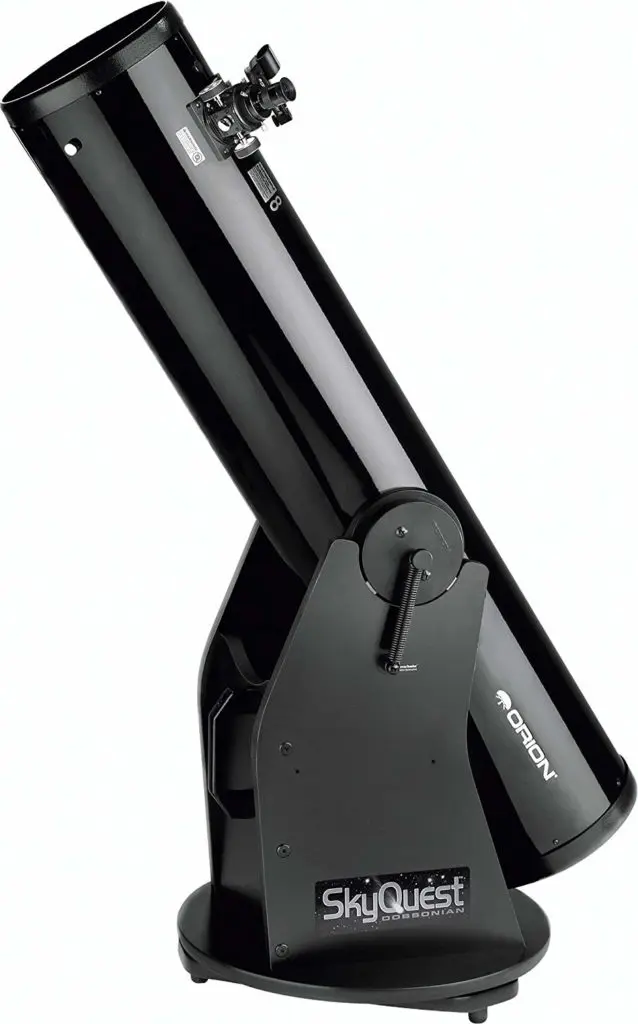
Dobsonian mounts are a special version of the altazimuth mount made for beginners. These mounts are grounded by heavy platforms and designed for large Newtonian reflector telescopes.
They are light, affordable, and great for any beginner or junior astronomer.
3. German Equatorial Mounts
Equatorial mounts (EQ) are made to watch the entire night sky and are very popular in astrophotography. They are easy to adjust on the fly and can be powered either manually or electronically.
The German version uses counterweights to properly balance the telescope on what is known as the polar axis. Aiming this axis towards Polaris aligns the entire mount with Earth’s rotation.
4. Fork Equatorial Mounts
Telescopes with shorter tubes tend to use fork mounts. These equatorial mounts balance telescopes at their center of mass and therefore do not need counterweights. The telescopes are mounted on two arms connected to a motor.
More hybrid than true equatorials, you can switch these mounts between AZ and EQ modes as needed. This makes them the most versatile but also heavier and less portable than any other mount.
5. Go-To Mounts
It’s basically a computer that will move the telescope to a location based on the axis of the body you want to see. There are normally hand controls that will move the mount smoothly and easily without much effort on the part of the user.
Telescope Tube
The telescope tube has the main mirror. Normally, the telescope tube has 8 inches diameter and it has a tube cover.
The telescope tube enhances the setting of the focal length through controlling the knob which is usually below the visual back. Therefore, the telescope tube makes an important part of the telescope functionality.
Other features
Besides all the above features, there are many other ones you can check to make sure you buy an ideal telescope for beginners which is going to meet your needs.
Refer to the section about Mounts, Eyepieces and Finderscope of this article before making a final purchasing decision.
Another factor to consider is the weight and the dimensions of the telescope.
Also, the included accessories which accompany the telescope should be checked – whether it has a tripod, a Barlow lens, a carrying bag, etc. Most of these accessories are generally included in telescopes under $500 and above.
Tripod
The tripod is made of at least three stands. It holds and retains the telescope on its surface. The tripod is made in a way that it can support the telescope in slanted, straight, or inverted positions. At the same time, an observer can easily move the telescope to different directions with ease.
Types Of Telescopes
Telescopes come in all shapes, sizes, and functions. There is a telescope type for each and every band of electromagnetic radiation from gamma rays to light to radio. However, the optical types are all you need. Optical telescopes may only work for visible light, but will let you see just about everything nature has to offer. There are three types of optical telescopes on the market and each has its own advantages and disadvantages.
1. Refractor Telescope
Refractor telescopes are the original, earliest type of telescopes. Basically, a long tube with a large lens in front and an eyepiece at the back.
The front lens (the objective) focuses light to form an image in the back. The eyepiece is a little magnifying glass with which you look at the image.
High-quality refractors are often sought out by lunar and planetary observers who value their crisp, high-contrast images that can take high magnification.
In fact, when well made a refractor can provide the finest images attainable with a given aperture.
Another advantage of the refractor is that it’s generally more rugged than other types of scopes, because it’s lenses are less likely to come out of alignment.
For this reason refractors are well suited to those who wish to have a portable telescope or who have no desire to tinker with the optics.
2. Reflector Telescope
The reflector telescope uses a mirror to gather and focus light. Its most common form is the Newtonian reflector (invented by Isaac Newton), with a specially curved concave (dish-shaped) primary mirror in the bottom end of the telescope.
Near the top a small, diagonal secondary mirror directs the light from the primary to the side of the tube, where it’s met by a conveniently placed eyepiece.
If you want the most aperture for your money, the reflector is the scope for you.
When well made and maintained, a reflector can provide sharp, contrasty images of all manner of celestial objects at a small fraction of the cost of an equal-aperture refractor.
There is another benefit – A reflector is, by and large, the only type of telescope that shows you a “correct-reading” image rather than a mirror image.
This is especially important when you’re trying to compare what you see in the eyepiece to what’s on a star map.
3. Compound Telescope
The third kind are the catadioptric or compound telescope.They employ both lenses and mirrors to form an image.
The greatest appeal of these instruments is that, in their commonly encountered forms (the Schmidt-Cassegrain and Maksutov-Cassegrain), they are very compact.
Their tubes are just two to three times as long as wide, an arrangement allowed by “optical folding” of the light. The smaller tube can use a lighter and thus more manageable mounting.
The upshot is that you can obtain a large-aperture, long-focus telescope that’s very transportable.
Like the Newtonian, the Schmidt-Cassegrain telescope needs occasional optical collimation that lessens its appeal to those who are not too keen to tinker with the mechanics of a telescope.
Their fields of view can be rather narrow, too. In terms of cost the catadioptric lies midway between the reflector and the refractor.
Words Of Advice For Amateur Astronomers
Amateur Astronomy can be fun, educational, and very interesting. However, being a backyard stargazer is not all fun and games.
There are a few things you should keep in mind if you want to be a successful amateur astronomer. Here we have gathered a few practical tips that you can put to good use if you want to start getting more familiar with the night sky.
Invest in Books, Not a Telescope, First
Telescopes are expensive. Buy a stargazing book or two, first. After a few months, gauge your own interest. For some people it will still be there. For others, not so much.
Learn your way around a telescope
When you finally start setting up your telescope, take whatever time is needed to learn its use and operation. Be sure that you have assembled everything with great care.
In the beginning, practice how to aim and focus your new instrument on daytime terrestrial objects. Not only are they bright and easy to see, but unlike night sky objects, they will not drift out of your field of view due to Earth’s rotation.
Find a right spot for stargazing
You should look for a place where you can get a good view of the night sky. Avoid light pollution, if possible. For some living in the big city this might mean finding a spot outside of town. Those living in the countryside might want to look for a place free of trees that will obscure your view.
Move your telescope in the shadows
Try to find a spot in your backyard that is in shadow to improve the contrast of objects.
Some astronomers have even had success building their own shielding to block out local streetlights.
Buy red tinted glasses to speed up dark adaptation
You will always see more through your scope once your eyes have adapted to the darkness.
Your eyes can take 20 – 40 minutes to adapt fully.
You can also buy orange tinted glasses for the same effect. They also work as blue light blockers which are said to prevent the delay of melatonin build up before sleep.
Wearing them for a short time indoors before you step outside will start the activation of the ‘night vision’ receptors in your eyes.
Set your telescope up away from concrete if possible
Concrete radiates heat stored up over the day, causing air disturbance around you, which means poorer seeing conditions. This is particularly apparent on a hot day.
If you can, avoid pointing your telescope over the roofs of houses. Houses radiate heat if not well insulated.
Ideally, you want to point your telescope over grass, which uses up the Sun’s energy in the day through photosynthesis and does not radiate the heat back out at night.
Join an amateur astronomy club
Join a local astronomy club. You can probably locate the one nearest to you by consulting the website of the Astronomical League (AL), by far the largest national organization of amateur astronomers (http://www.astroleague.com).
The AL is composed of scores of local amateur astronomical clubs and groups, totaling thousands of individuals.
By attending local club meetings, you’ll get to meet any number of fellow sky gazers who can offer you valuable advice.
If you own a telescope, but are experiencing problems with it, there is no better place to go than an astronomy club whose members can offer assistance and helpful suggestions.
Which are the best nights for stargazing?
Those cold winter nights that leave us shivering might be less pleasant than a warm summer’s night, but winter nights tend to have less humidity in the air, which reduces haze and makes for great ‘seeing’.
So depending on where you are in the world, if you intend to spend the requisite nighttime hours to get a grasp on what is above you, be prepared with warm clothes, snacks, and a firm resolve. We suggest investing in a red flashlight or a headlamp with that function so as not to affect your hard-earned night vision or that of your viewing partners.
Conclusion
Our top pick for the best telescope for amateurs is the Celestron – PowerSeeker 127EQ. The Celestron PowerSeeker 127EQ is an easy-to-use and powerful telescope. The PowerSeeker series is designed to give the new telescope user the perfect combination of quality, value, features, and power
Our next best telescope for amateurs is the Gskyer Telescope AZ90600. This 90x600mm refractor telescope can be a good observation of celestial bodies and terrestrial objects – best for viewing Lunar and Planetary. Featuring all coated glass optical components,our telescope provides clean, crisp views.
Written by:

Chandrashekhara Rao
I grew up in a rural community with a dark sky, and that is where I learned to appreciate planets and stars at an early age. I have been fascinated with all things astronomical since I was a kid and started with a cheap-and-cheerful 60mm refractor on a wobbly tripod.
ABOUT US
We are a team of active amateur astronomers, here to help you with all your astronomy and science related needs – this is anything, from reviewing the latest telescopes to be released to talking about gravity and neurons. The Big Bang Optics was started because of our love for astronomy and to help others like us find the best telescope and accessories.
LEGAL DISCLAIMER
The Big Bang Optics is a participant in the Amazon Services LLC Associates Program, an affiliate advertising program designed to provide a means for sites to earn advertising fees by advertising and linking to Amazon.com. The Big Bang Optics also participates in affiliate programs with Clickbank and other sites. The Big Bang Optics is compensated for referring traffic and business to these companies.








